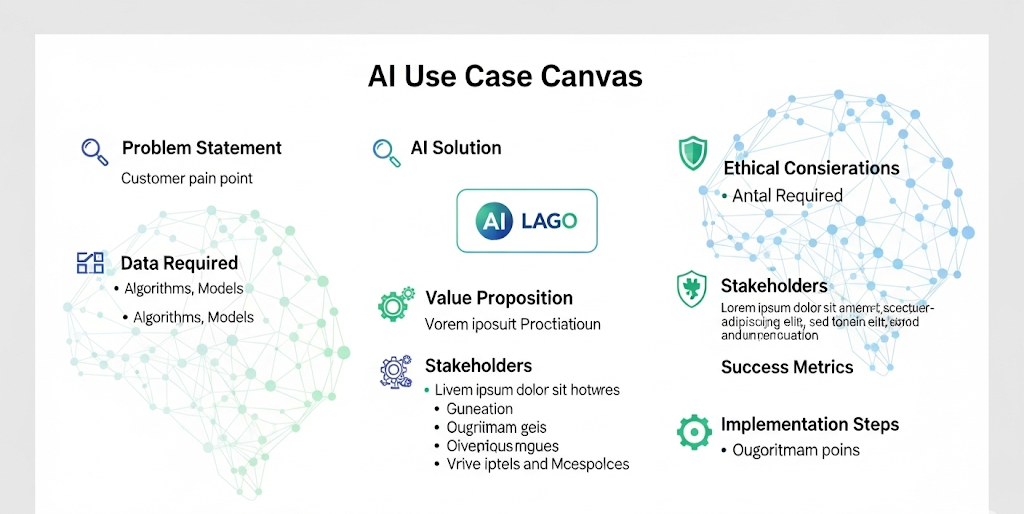In today’s rapidly evolving tech landscape, businesses are turning to artificial intelligence (AI) to solve complex challenges and improve efficiency. But with so many options available, how can you ensure your AI project aligns with your business objectives? Enter the AI Use Case Canvas.
Think of the AI Use Case Canvas as a roadmap that helps organizations assess AI solutions, understand the necessary resources, and measure potential outcomes. If you want to unlock AI’s full potential for your business, learning how to effectively use this tool is key. In this article, we will explore the AI Use Case Canvas in detail and show you how to apply it to your next AI project.
What is the AI Use Case Canvas?
The AI Use Case Canvas is a strategic framework designed to help organizations evaluate the feasibility and impact of AI use cases. It outlines essential components such as the problem to solve, the AI solution, stakeholders involved, and potential business value. By using this canvas, you can break down complex AI projects into manageable components, making it easier to align them with your business goals.
How the AI Use Case Canvas Works
Key Components of the AI Use Case Canvas
The AI Use Case Canvas typically includes the following key sections:
-
Problem Statement
This section defines the challenge your organization is facing. What is the business issue or opportunity that AI can address? -
AI Solution
Here, you specify the AI technology or approach that you intend to use. Whether it’s machine learning, natural language processing, or robotics, this section highlights the solution’s core functionalities. -
Business Impact
This part focuses on the benefits AI will bring to your organization. It might include efficiency improvements, cost savings, enhanced decision-making, or customer satisfaction. -
Data Requirements
AI models rely heavily on data. This section identifies the data needed for the AI system to function effectively, such as historical data, real-time data, or customer information. -
Stakeholders
The stakeholders include everyone involved in the AI project, from business executives to technical teams. This section ensures all players are aligned on the project’s objectives. -
Technical Feasibility
This section evaluates whether the necessary technical infrastructure, resources, and expertise are in place to implement the AI solution. -
Performance Metrics
To assess the success of the AI project, it’s essential to set clear performance metrics. These could include accuracy, efficiency, ROI, or user engagement.
Benefits of Using the AI Use Case Canvas
1. Structured Approach to AI Projects
The AI Use Case Canvas helps you organize your thoughts and identify all critical components of your AI project. With a clear structure in place, you’re less likely to miss key details or overlook important factors.
2. Clear Alignment with Business Goals
By explicitly identifying the business impact, you ensure that your AI initiatives are directly aligned with organizational goals, whether that means increasing revenue, cutting costs, or improving customer experience.
3. Helps in Resource Planning
AI projects require significant resources, including data, tools, and skilled personnel. The AI Use Case Canvas helps identify what you need and whether you have the resources to execute the project.
4. Risk Mitigation
By considering technical feasibility and performance metrics upfront, the AI Use Case Canvas helps you anticipate and mitigate potential risks, making the project more likely to succeed.
5. Cross-Department Collaboration
With sections that involve stakeholders from different parts of the organization, the AI Use Case Canvas fosters collaboration and ensures everyone is on the same page.
Example: Using the AI Use Case Canvas in a Real Business Scenario
Let’s say you’re running a customer service center and want to improve response time and customer satisfaction. By using the AI Use Case Canvas, you can break down the project as follows:
-
Problem Statement: Slow response times and high customer dissatisfaction in handling queries.
-
AI Solution: Implement a chatbot that uses natural language processing to answer common queries instantly.
-
Business Impact: Reduced response time, higher customer satisfaction, and increased operational efficiency.
-
Data Requirements: Historical customer service chat logs, real-time customer interactions.
-
Stakeholders: Customer service team, IT department, management.
-
Technical Feasibility: Ensure the chatbot integrates with existing systems and can scale as needed.
-
Performance Metrics: Average response time, customer satisfaction scores, reduction in human agent workload.
Tools for Creating and Using the AI Use Case Canvas
Here are some popular tools you can use to create and manage your AI Use Case Canvas:
| Tool | Description | Benefits |
|---|---|---|
| Miro | An online collaborative whiteboard tool for mapping out ideas. | Easy to use, flexible, supports team collaboration. |
| Canvanizer | A simple tool to create canvases with pre-defined templates. | Quick to set up, ready-made templates for AI use cases. |
| Lucidchart | Diagramming tool that can be used to create custom canvases. | Visualizes complex workflows, great for team collaboration. |
| Airtable | A versatile project management tool that can manage AI use cases. | Combines database functionality with ease of use. |
Best Practices for Creating AI Use Cases
-
Start with a Clear Problem: Define the problem you want to solve clearly. An unclear or too broad problem will make it harder to measure the success of your AI solution.
-
Involve Key Stakeholders Early: Engage everyone involved in the project from the start to ensure alignment on goals and resources.
-
Focus on Measurable Outcomes: Set clear performance metrics that you can track and evaluate to ensure the AI solution delivers the promised value.
-
Test Before Full-Scale Deployment: Start with a pilot project or prototype to test the AI solution in a real-world environment and make adjustments as needed.
Conclusion: Start Your AI Journey Today
The AI Use Case Canvas is an essential tool for any organization looking to implement AI solutions effectively. It provides a structured, clear framework that helps teams navigate complex AI projects and aligns them with business objectives. By using this canvas, you can ensure your AI initiatives deliver real, measurable value.
Ready to dive into AI for your business? Start by mapping out your AI use cases today using the AI Use Case Canvas, and set yourself up for success!
FAQs
What is the AI Use Case Canvas and why is it important for businesses?
The AI Use Case Canvas is a strategic tool that helps businesses structure AI projects, assess feasibility, and align solutions with business objectives to ensure successful outcomes.
How can the AI Use Case Canvas improve AI project success rates?
By clearly defining key components like problem statements, AI solutions, and performance metrics, the canvas helps businesses stay focused, reduce risks, and ensure alignment with organizational goals.
Can the AI Use Case Canvas be used for both small and large-scale AI projects?
Yes, the AI Use Case Canvas is flexible and can be adapted to projects of any size, from small AI experiments to large-scale enterprise implementations.
What are the key components of the AI Use Case Canvas?
The canvas includes sections such as problem statement, AI solution, business impact, data requirements, stakeholders, technical feasibility, and performance metrics.
How do I get started with the AI Use Case Canvas?
Start by identifying the problem or opportunity AI will address, then map out the solution using the canvas’ sections, ensuring that every component is aligned with your business goals.








Leave a Reply